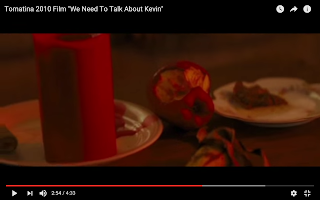Pitch: Think Reservoir Dogs meets Fargo, with the social realist aspect of Fish Tank. An urban, 70s style crime thriller with an edge of satire.
 |
| Reservoir Dogs (Quentin Tarantino) |
 |
| Fargo (Ethan and Joel Coen) |
 |
| Fish Tank (Andrea Arnold) |
Audience: Certificate 15. The film will be aimed at 15 - 25 year olds.
Plot: A small scale murder investigation.
A young girl (17/18 years old) will come across a dead body and go to the authorities. (It is someone she knew, but not particularly close to.) It then becomes apparent that she has been involved in the murder and becomes a suspect, but she has no idea or recollection of why she is. The plot becomes the story of her and her own personal investigation of piecing together the murder, with the sub-plot of the two investigators officially solving the case.
Style / tone: A combination of contemporary quirk and social realism.
The visuals will be stylised and full of semiotics (e.g. deep red = murder and blood, green = suspicion and threat, blue = sadness and peacefulness). These colours will be obvious, and the shots will be close framed in order to add significance to everything the eye sees. I would like to use both the 'golden hour' light when the sun is low in the sky, and the night sky with light from street lights would be atmospheric and appropriate.
 |
| An example of close framed shots with colour semiotics. (We Need To Talk About Kevin, Lynne Ramsay) |
Characters:
- The young woman / girl. 17/18 years old. Quite hardy/tough looking.
- Investigator one: Young - 18 or 19 years old. Perhaps an apprentice to the elder.
- Investigator two: Older - 40s. Experienced.
Costume: Ideally I want the film to look as if it is set in the 70s; outfits including leather jackets, high waisted trousers, denim, flares, stripes, shirts, sneakers, doc martens etc would be suitable.
 |
The Runaways (Floria Sigismondi)
|
Graphics: The credits will appear at the bottom of the screen but will not take the viewer's attention away from the visuals.
The film title will appear in large bold writing, overlaid on to the film footage, flashing on screen in time with the soundtrack in an intense, fast paced part of the sequence.
 |
| Kill Your Darlings (John Krokidas) |
Sound: At the start there will be either no soundtrack or a soundtrack which is background noise compared to the enhanced diegetic sound (e.g. cars driving, trains rolling, footsteps, breathing etc.) This enhanced sound will help the audience pay attention to detail. However, when the sequence becomes fast paced (perhaps during a chase), the soundtrack will replace all diegetic sound - this music will sound similar to 70's style rock. (This will help the element of satire but also bring more excitement into the scene).


































